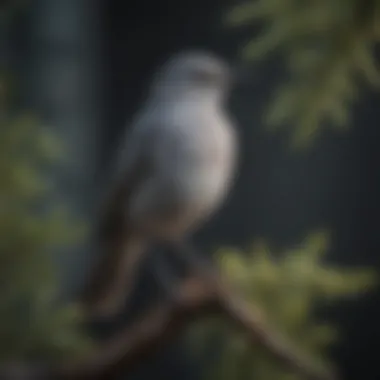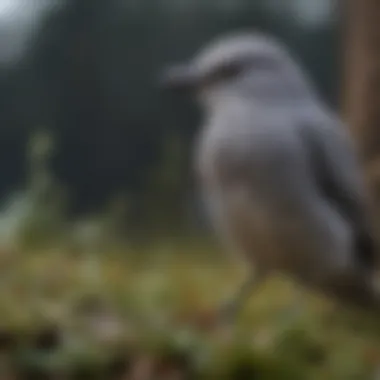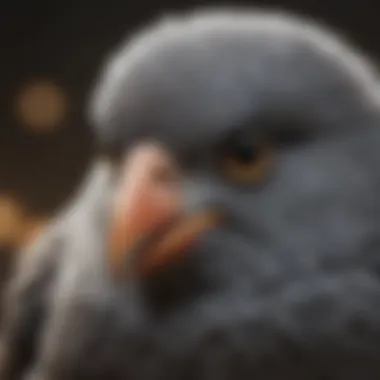Understanding Grey Birds: Their Behavior and Care


Intro
Grey birds often exist in the shadows, overlooked while vibrant species grab the spotlight. This article seeks to illuminate the lives of these understated avians, emphasizing their significant role within ecosystems and as companions. Understanding grey birds allows both enthusiasts and potential pet owners to appreciate their unique behaviors and needs.
In this guide, we will explore species diversity, delve into behavioral traits, and outline essential care practices. The aim is to equip readers with knowledge, enabling a deeper connection with these fascinating creatures.
Intro to Grey Birds
The exploration of grey birds is essential for several reasons. Grey birds are often overlooked due to the common belief that they lack the vibrant colors found in other avian species. However, this leads to an undervaluation of their unique characteristics and ecological importance. Understanding grey birds can enhance our appreciation for biodiversity and the specific roles these birds play within their environments.
In this article, we will cover various aspects of grey birds including their diverse species, unique behaviors, and care requirements. Bird enthusiasts, families, and potential pet owners will find this guide valuable. It addresses not only the fascination surrounding these birds but also their significance in ecosystems.
- Key Elements to Consider: The article highlights the behavioral traits, habitats, and conservation status of grey birds. This information is relevant for anyone who wants to learn about these fascinating creatures, whether for personal interest or for responsible ownership.
- Benefits of Understanding Grey Birds: For pet owners, knowing how to properly care for grey birds is crucial. This includes understanding their dietary needs, housing conditions, and health considerations. Furthermore, discovering the roles grey birds play in their ecosystems can inspire efforts toward their conservation, which is increasingly important in a rapidly changing environment.
Overall, this introduction serves as a gateway into the diverse world of grey birds, setting the foundation for a more detailed exploration in subsequent sections.
Diversity of Grey Bird Species
The diversity of grey bird species provides a deep insight into the ecological fabric of our planet. Grey birds can be found across various habitats, showcasing an impressive array of adaptations, colors, and behaviors. Understanding this diversity is essential, as it not only highlights the richness of avian life but also underscores the importance of conservation efforts. Many species of grey birds occupy critical roles in their ecosystems, influencing food chains and contributing to biodiversity.
Common Species Identification
Identifying common grey bird species is crucial for bird enthusiasts and pet owners alike. Different grey bird species exhibit distinctive features that can help with identification. Here are some prominent characteristics of a few common grey birds:
- American Crow: Recognizable by its all-black feathers, the American crow has a distinctive call and is very intelligent. Its adaptability has allowed it to thrive in urban environments.
- Dove: Known for their gentle cooing, doves have smooth, grey feathers and are often found in suburban areas.
- Eastern Gray Squirrel: While not a bird, they are often associated with grey birds in urban settings due to their interaction with the same habitats.
When observing grey birds, note the size, beak shape, and vocalizations to aid in identification. Field guides or mobile apps can be valuable tools in this process.
Endangered Grey Bird Species
Among the extensive family of grey birds, certain species face serious threats, making them endangered. Endangered grey bird species provide insight into ecological imbalances and the degradation of natural habitats. Saving these species requires concerted conservation efforts. Some notable examples include:
- California Condor: Once nearly extinct, this species has become a symbol for wildlife conservation, efforts are still ongoing to recover its population.
- Grey-cheeked Thrush: This migratory bird is threatened due to habitat loss and climate change, impacting its breeding and feeding patterns.
- Ash-throated Flycatcher: It faces risks primarily from habitat destruction and changing landscapes.
The ongoing loss of habitat is a primary reason for the endangerment of these grey birds. Conserving their environments is essential for their survival.
Recognizing endangered grey bird species not only raises awareness but also fosters a commitment to preservation actions. Promoting conservation through education and advocacy is vital for restoring these populations for future generations.
Habitat and Distribution
Understanding the habitat and distribution of grey birds is vital for appreciating their behavior and care. Grey birds are found in various environments, which directly impacts their survival, feeding habits, and social interactions. Each species has adapted to specific habitats, leading to unique ecological roles. Evaluating their natural habitats helps us gain insights into conservation needs and how best to provide for them in captivity.
Natural Habitats of Grey Birds
Grey birds can be found in diverse habitats, including forests, grasslands, wetlands, and urban areas. For example, the Mourning Dove primarily inhabits open areas such as fields and roadside shrubby lands. Meanwhile, the Grey Catbird prefers dense shrubbery and woodland edges. These variations depend on several factors, including food availability, nesting sites, and climate conditions.
In forested regions, grey birds often build nests high in trees, where they can find protection from predators. For species like the Eurasian Collared-Dove, grasslands offer ample food sources. Such biodiversity is crucial, not only for the birds but also for the broader ecosystem, as they contribute to pest control and seed dispersal.
Adaptation to Urban Environments
Many grey bird species show incredible adaptability to urban settings. Cities, parks, and suburban areas have become suitable habitats for species like the Grey Jay and the Rock Pigeon. These birds adjust their feeding habits to include human-provided food sources, such as discarded scraps or bird feeders.
"Urban environments have expanded the range of grey birds, presenting new challenges and opportunities for survival."
However, this adaptation does come with risks. Urban areas can expose grey birds to pollution, habitat destruction, and reduced food sources due to human activities. Careful management of these environments is essential to ensure that grey birds thrive and continue fulfilling their ecological roles. For those who keep grey birds as pets, understanding their natural habitat can lead to better care and environments that mimic those they are adapted to.


Behavioral Characteristics
The study of behavioral characteristics in grey birds is essential for understanding their complexities. This article explains not only what behaviors are typical among grey birds, but also how these traits can influence their interactions in the wild and in domestic settings. By grasping the nuances of grey birds’ behaviors, we can enhance our appreciation and care for these creatures, whether they are observed in nature or kept as companions.
Social Behaviors in Grey Birds
Grey birds exhibit a rich array of social behaviors, which are crucial for their survival and prosperity. These behaviors often reflect their adaptability and intelligence. Social interactions can vary significantly by species. Some grey birds prefer solitary living, while others thrive in groups.
Many grey bird species, such as the African Grey Parrot, are known for their strong social bonds. They can form tight-knit flocks, where they engage in cooperative behaviors. This includes activities like grooming each other and sharing food. For those considering pet ownership, understanding these social quirks is vital. Social birds require stimulation and companionship. Without adequate interaction, they may develop behavioral issues.
"Understanding social behaviors helps in fostering a healthy environment for grey birds, both in the wild and at home."
Here are some common social behaviors in grey birds:
- Flocking: Birds often travel and feed in groups, enhancing safety against predators.
- Grooming: They groom each other, which strengthens social bonds.
- Territorial displays: Some species establish territories through vocalizations and posturing to communicate dominance.
Observing these behaviors in grey birds can inform pet owners about the importance of interaction. Birds need cognitive challenges and the presence of their human companions or other pets to remain content. Socializing them during their formative years is recommended to develop balanced personalities.
Communication Patterns
Communication is a fundamental aspect of grey bird behavior. These avians utilize a variety of vocalizations and body language to convey messages. Understanding their communication patterns is helpful for caretakers and enthusiasts alike.
Grey birds are known for their ability to mimic sounds, including human speech. This ability stems from their social nature; they mimic to bond or communicate with their flocks. Common Grey Parrots, for example, can develop extensive vocabularies and even learn to associate words with their meanings.
Communication methods include:
- Vocalizations: Varies by species, ranging from melodic calls to rapid chattering.
- Body Language: Postures, feather ruffling, and wing positions signal moods or intent.
- Visual Signals: Direct eye contact or specific movements can indicate readiness to mate or establish dominance.
Recognizing these cues is essential for effective interaction. It helps pet owners respect a bird’s mood, allowing them to engage on the bird's terms. A harmonious channel of communication fosters trust and enhances well-being.
In summary, the behavioral traits of grey birds showcase their adaptability and intelligence. Recognizing their social behaviors and communication patterns can significantly improve the relationship between grey birds and their human companions.
Caring for Grey Birds
Caring for grey birds is a crucial aspect that requires attention and understanding. These birds, much like others, need a proper environment and diet to thrive. The importance of proper care cannot be understated. When owners provide appropriate care, they ensure that these birds remain healthy and content throughout their lives. Therefore, it is essential to consider their specific needs, which can vary based on species, but share many commonalities.
Nutritional Requirements
The nutritional needs of grey birds are quite specific. A well-balanced diet is vital to their health. Common staples include seeds, fruits, and vegetables. Pelleted diets, like Harrison's Bird Foods or ZuPreem, offer complete nutrition as well.
While seeds can be an enticing option, they should not constitute the only part of their diet. A diet high in seeds can lead to health issues like obesity and fatty liver disease. Including a variety of foods will ensure that grey birds receive essential vitamins and minerals.
Some nutritional highlights include:
- Fresh vegetables like kale, carrots, or bell peppers, rich in vitamins.
- Fruits such as apples, bananas, and berries, which provide antioxidants.
- Calcium sources, important for bone health, like cuttlebone or mineral blocks.
It is also important to avoid specific foods that can be toxic, such as avocado, chocolate, and caffeine. A keen awareness of dietary needs will promote a long and healthy life for these birds.
Housing and Environment Needs
Housing for grey birds must provide both comfort and stimulation. The cage should be spacious enough for them to move freely. A good rule is to choose a cage that is at least two times the wingspan of the bird in width, height, and depth.
Items to consider when setting up the environment include:
- Perches: Use a variety of materials and sizes to strengthen their feet and prevent boredom.
- Toys: Puzzle toys can stimulate their minds, while chewable toys help maintain beak health.
- Natural elements: Branches or natural bedding can mimic their natural habitat.


These aspects ensure the psychological and physical well-being of grey birds. Frequent interaction and time outside the cage are equally important for their social development.
Health Considerations
Health management is a fundamental part of keeping grey birds. Regular veterinary check-ups can prevent many health issues. Bird-specific veterinarians can provide valuable insight into potential problems.
Common health considerations include:
- Signs of illness: Over time, watching for changes in behavior, eating patterns, or droppings can catch issues early.
- Vaccinations: Some grey birds may benefit from routine vaccinations based on their environment.
- Mental health: Stress can manifest physically; thus attention to their social needs and providing stimulation is crucial.
Regular check-ins with a vet and a carefully monitored diet can lead to a significant difference in their overall health.
In summary, to care for grey birds effectively, focus on nutrition, appropriate housing, and ongoing health management. Each of these aspects plays a vital role in enhancing the quality of life for these birds and ensuring they remain vibrant and healthy companions.
Grey Birds in Popular Culture
Grey birds are not just remarkable for their ecological roles; they also occupy a notable space in popular culture. This section highlights how these birds are represented in literature and art, as well as the symbolism they evoke. Understanding these aspects is crucial for recognizing the broader cultural and emotional significance that grey birds hold in society.
Representation in Literature and Art
Grey birds have appeared in various literary works and art forms throughout history. Their presence often reflects the environment, emotions, or themes deeply explored by the creators. For instance, in literature, grey birds can symbolize loss, melancholy, or resilience. These themes resonate with many readers, creating a powerful connection between the audience and the narrative.
In art, grey birds are frequently depicted in paintings and sculptures. Artists may portray them in their natural habitats or incorporate them into abstract works to elicit a specific mood. The subtle hues of grey enhance the visual impact, making these birds an appealing subject.
Noteworthy examples include the European Starling, often featured to symbolize adaptability. Additionally, the mourning dove in various art pieces evokes feelings of solitude and reflection, further influencing public perception of these creatures.
Symbolism of Grey Birds
The symbolism associated with grey birds can vary greatly depending on cultural contexts. In many traditions, grey represents neutrality, balance, and calmness. Grey birds embody these traits, serving as a reminder of nature's equilibrium. They are often seen as messengers, bridging the realms of the earth and sky. This perception contributes to their representation in stories and folklore as symbols of transition or change.
When stylized in art, grey birds can embody hope amid darkness. For example, in various cultures, their representation has intersected with themes of hope, wisdom, and mystery. Oftentimes, they remind people to find beauty in the mundane and recognize the importance of their surroundings.
Overall, the presence of grey birds in popular culture goes beyond mere representation. They arise discussions about nature, emotion, and human experience, enhancing our understanding of them in both artistic and conceptual frameworks.
Conservation Efforts
Conservation efforts for grey birds are crucial for maintaining biodiversity and ensuring the ecological balance within their habitats. These birds play significant roles in their ecosystems, serving as seed dispersers and insect population controllers. Protecting their populations helps preserve these vital functions, which in turn supports the larger environmental health. Conservation initiatives also enhance awareness about the importance of preserving grey birds and their habitats, making it critical for communities and policymakers alike.
Role of Grey Birds in Ecosystems
Grey birds can be found in a variety of roles within their ecosystems. For instance, many grey bird species consume substantial amounts of insects, assisting in controlling these populations. This natural pest management helps farmers and gardeners by reducing the need for chemical pesticides. Additionally, grey birds often participate in seed dispersion. By carrying seeds to new locations, they contribute to the growth of different plant species, promoting vegetation diversity.
Moreover, grey birds form part of the food web. They are prey for various larger predators, linking them to a range of species in their ecosystem. The loss of grey birds can have cascading effects, leading to imbalances in the populations of both plants and animals.
"The conservation of grey birds is not just about protecting a single species, but rather about maintaining the interconnected web of life in which they operate."
Ongoing Conservation Programs
Several conservation programs focus specifically on grey birds and their needs. These programs are essential as they address habitat destruction, climate change effects, and a habitat loss caused by urban development. Some international organizations, including the Audubon Society and BirdLife International, work towards protecting grey bird habitats and educating the public about their significance.
Local community initiatives often complement these larger efforts. They may involve restoring native vegetation in urban areas where grey birds can thrive. Community members are often encouraged to participate in bird-watching events, educational workshops, and collaborative habitat restoration projects.
Additionally, research projects aim to monitor grey bird populations, assess their health, and identify threats they face. By gathering data and sharing findings with conservationists, researchers help shape effective strategies for protecting these birds.
Research and Studies


The study of grey birds encompasses diverse aspects such as their behavior, ecology, and care. This is essential for improving our understanding and appreciation of these species. Thorough research helps to outline their natural habits, revealing complex social structures and adaptations that assist their survival.
Benefits of understanding grey birds through research include enhancing conservation efforts and improving care for pet owners. Gaining insights from studies provides significant knowledge on how to maintain healthy environments, both in the wild and captivity. Furthermore, understanding their ecological roles can guide conservation initiatives, preserving their habitats and populations.
Key Research Findings
Recent studies have shown that grey birds exhibit a wide range of behavioral adaptations. For example, research indicates that certain species develop unique social behaviors that facilitate their survival. This can be seen in the Grey Jay, which showcases cooperative breeding. Studies also reveal that these birds have remarkable communication skills. They can convey different messages through vocalizations and body language, a key aspect for social interactions.
Another important finding is the impact of urban environments on grey bird species. Research has highlighted how these birds adapt to changing landscapes, often showing resilience in urban settings. For instance, studies on the Eurasian Magpie demonstrate its ability to thrive in city life by altering its foraging techniques.
Future Research Directions
Future studies on grey birds can focus on various aspects that remain inadequately explored. One promising direction is examining the effects of climate change on their migratory patterns. It’s crucial to understand how shifting environments may influence their habits and breeding cycles.
Another area is the impact of urbanization on their health and social dynamics. Research can investigate how grey birds adjust to human interferences, like noise pollution and habitat destruction.
Additionally, studies could explore genetic variations among grey bird populations. Understanding genetic diversity helps conservationists develop strategies to protect these species.
"Evaluating the long-term effects of environmental changes on grey birds is vital for understanding their future survival and adaptability."
Pet Ownership Considerations
Bringing a grey bird into your home as a pet can be a significant decision that impacts your life and that of the bird. Understanding grey birds' needs, behaviors, and social dynamics is essential for anyone considering this unique companionship. This section will evaluate the advantages and disadvantages of keeping grey birds while providing guidelines for potential owners to prepare for this commitment.
Pros and Cons of Keeping Grey Birds
Owning a grey bird can be rewarding, but it is not without its challenges. Here are some key points to weigh when considering pet ownership:
Pros:
- Intelligence: Grey birds, such as African Grey Parrots, are exceptionally intelligent. They can learn to mimic words and phrases, engage in problem-solving, and display complex social behaviors.
- Companionship: Just like a dog or cat, these birds can form strong bonds with their owners. Many people find that grey birds can be affectionate and even respond to human emotions.
- Low Allergy Risk: Compared to fur-bearing pets, birds produce fewer allergens, making them a suitable option for families with allergies.
- Longevity: Grey birds often live for several decades, meaning they can be long-term companions.
Cons:
- High Maintenance: Feeding, grooming, and providing social interaction can be time-consuming. Grey birds require a lot of attention.
- Noise Levels: They can be quite vocal, sometimes leading to disturbances in quiet homes.
- Cost of Care: Initial costs involving cages, food, and veterinary care can add up. Regular health check-ups are necessary for their well-being.
- Behavioral Issues: If not properly socialized, grey birds can develop behavioral problems such as biting or screaming. Training them requires effort and patience.
Recommendations for Potential Owners
If you are considering a grey bird as a pet, several key aspects should be taken into consideration to ensure a harmonious relationship:
- Research: Learn about the specific species you are interested in. Familiarize yourself with their habits, temperaments, and special needs.
- Time Commitment: Assess your daily schedule. Grey birds require ample interaction and socialization. Ensure you have the time to devote to them.
- Space Requirements: Make sure your living space can accommodate a bird. They need a safe, spacious cage as well as time outside the cage for exercise.
- Diet: Understand their dietary needs. A balanced diet helps maintain their health. Consult with avian veterinarians for proper dietary guidelines.
- Social Opportunities: Consider your lifestyle. If you travel frequently or are often away from home, a grey bird might not be ideal. They thrive on social interaction and may become lonely or stressed.
- Consult Experts: Talk to existing pet owners and professionals. Visit forums on sites like Reddit for firsthand experiences. Check websites such as Wikipedia or Britannica for factual information on species.
By taking these considerations seriously, future owners can create a fulfilling and respectful environment for both themselves and their grey birds.
Ending
The conclusion of this article holds significant importance as it encapsulates the core findings about grey birds and their multifaceted nature. Understanding grey birds extends beyond mere observation. It intertwines with ecological awareness, pet ownership considerations, and the appreciation of their unique behaviors and roles within our environment.
Grey birds serve as vital indicators of ecosystem health. Insights gained from their behavior, habitat preferences, and diet can enrich our knowledge of biodiversity. This underscores the need for conservation efforts which are becoming increasingly crucial in the face of environmental challenges.
For pet owners or those considering grey birds for companionship, understanding their specific care requirements is essential. This includes recognizing their nutritional needs, habitat conditions, and behavioral characteristics. Making informed decisions leads to healthier, happier birds and fosters a deeper bond between humans and their avian pets.
In summary, the significance of grey birds reflects in their roles, care necessities, and cultural representations. The article aims to leave readers with a greater respect for these often-overlooked creatures, encouraging further exploration and understanding.
Summary of Key Points
- Grey birds are critical components of many ecosystems, indicating overall health.
- Their species diversity necessitates an understanding for effective conservation efforts.
- Pet ownership involves specific responsibilities; knowledge of dietary and housing needs enriches companionship.
- Awareness and appreciation of grey birds can lead to informed actions for their protection and welfare.
"Knowledge contributes to the survival and happiness of grey birds, both in the wild and as pets."
Understanding such dimensions fosters a culture of respect and responsibility towards our feathered friends.







